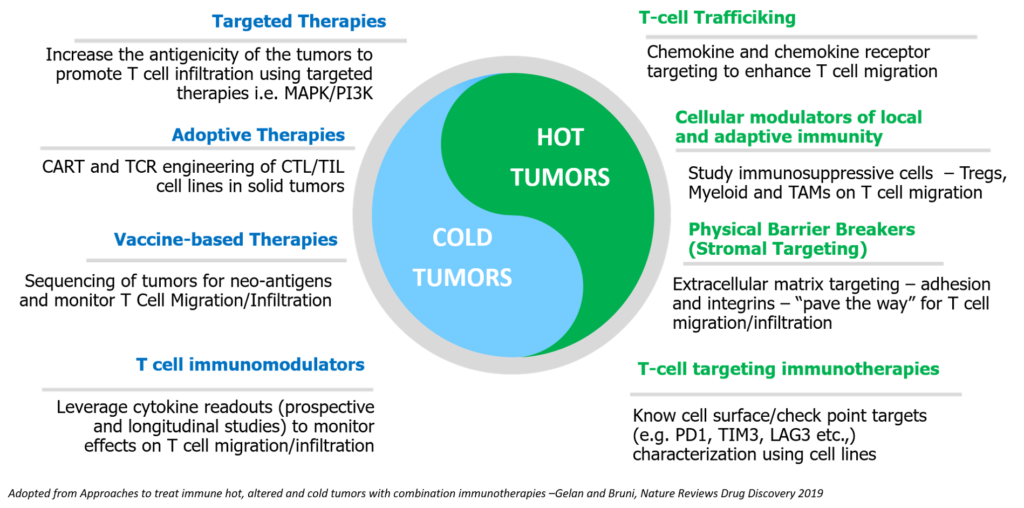IO Screening Modules
- Immune 3D can be used to assess factors that increase immune cell migration and infiltration, reduce the production of inhibitory factors and the recruitment of suppressive cells, modulate cellular adhesion, integrins, chemokines and nutrient availability.
- IMMUNE 3D® can be used to assess factors modulating immune cell function, such as immune checkpoints or inhibitor receptor expression.
- Spatial/ temporal relationships between immune cells, tumor cells and surrounding stroma.
- IMMUNE 3D® can be set in the presence and absence of immune cells providing a reproducible and affordable platform (compared to in vivo systems) to assess the impact of specific compounds on the tumor microenvironment and the relative contribution of the immune system.
- Importantly, the impact of specific compounds on human tumors and human immune cells can be observed and characterized.
- IMMUNE 3D® can be used in combination with immune suppressive agents such as chemotherapy, pharmacological inhibitors, as well as with cells that have been genetically manipulated in order to elucidate the mechanisms impacting anti-tumor immunity.
- Our system provides a novel platform to assess synthetic lethality and the impact of targeting defective DNA repair in cancer cells on anti-tumor immunity.

Example Studies
Modulation of checkpoint pathways such as PD-1/PD-L1 are leading to an expansion of therapies across broad disease areas such as infectious diseases and autoimmune diseases. Example studies conducted:
- Blockade of a checkpoint target expressed on our HLA-matched CTL and observing changes in T cell migration
- Screening of bispecific antibodies in comparison with the single target antibody to measure T cell migration and tumor lysis with cytokine readouts
- Measured chemokines and chemokine receptors involved in CTL migration in response to checkpoint blockade therapy
- Blockade of a checkpoint target expressed on our HLA-matched CTL and observing changes in T cell migration
- Screening of bispecific antibodies in comparison with the single target antibody to measure T cell migration and tumor lysis with cytokine readouts
- Measured chemokines and chemokine receptors involved in CTL migration in response to checkpoint blockade therapy
CAR-T therapies have paved the way for a next generation cancer therapies and have made tremendous progress in hematological malignancies. The next wave of CAR-T applications is the treatment of solid tumors. IMMUNE 3D® is designed to address certain challenges with existing models systems in screening of CAR-T therapies against low-density targets, low T cell infiltration and or induction of T cell hypofunction and creating the immunosuppressive environment. Example studies conducted are:
- Measuring tumor lysis in melanoma and colon cancer
- Dose optimization and changes in cytokine profiles
Chemokines play a pivotal role in lymphocyte migration and mediating immune responses across broad diseases. Several chemokine targeting antibodies are in development for broad therapeutic application. IMMUNE 3D® has extensive experience in studying chemokines and chemokine receptor profiles in response to a drug candidate. Studies conducted to date are:
- Effect of blocking SDF1α and CXCR4 in T cell migration in the presence/absence of checkpoint blockade therapy – fluorescence tracking of CTL migration.
- Time course study of chemokine profiles in response to a checkpoint drug candidate – measured tumor lysis at various timepoints.
- Chemokines and chemokine receptors in response to targeting Myeloid Derived Suppressor Cells (MDSCs)
- Measure chemokine expression in response.
While immune-mediated therapies have gained traction over the past decade, therapies that target key mutations on disease cells or tissues continue to be as important in patient therapy. IMMUNE 3D® has conducted extensive studies to screen targeted therapies based on mutations expressed on cell lines or patient samples. Studies conducted are:
- Combination of HDAC therapies and anti-PDL1 to measure CTL migration and cytokine responses
- Combination of Braf inhibitors and anti-PD1 (Keytruda) and monitor the changes in cell surface expression of checkpoint targets
- Measured changes in signaling pathways in response to targeted therapy – measures chemokine and cytokine profiles.
